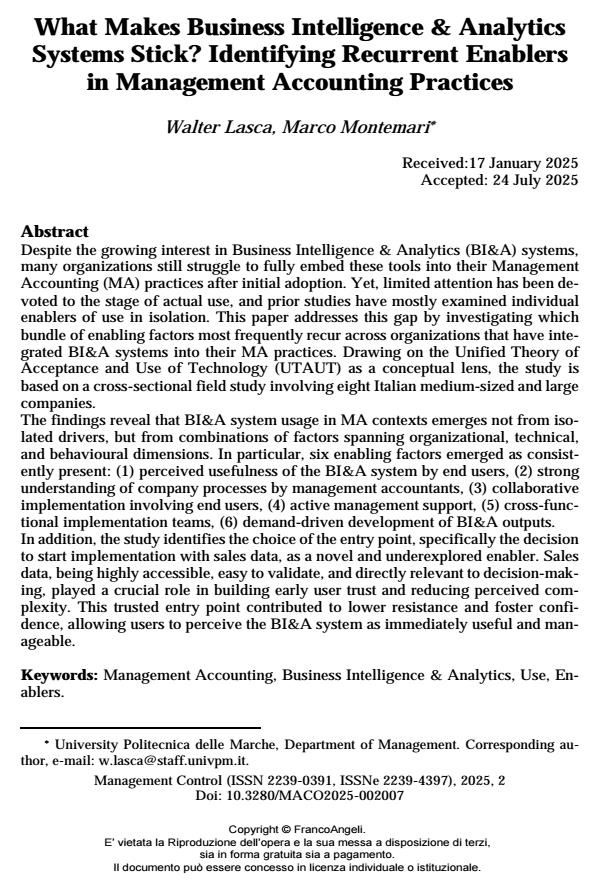What Makes Business Intelligence & Analytics Systems Stick? Identifying Recurrent Enablers in Management Accounting Practices
Titolo Rivista MANAGEMENT CONTROL
Autori/Curatori Walter Lasca, Marco Montemari
Anno di pubblicazione 2025 Fascicolo 2025/2
Lingua Inglese Numero pagine 24 P. 133-156 Dimensione file 325 KB
DOI 10.3280/MACO2025-002007
Il DOI è il codice a barre della proprietà intellettuale: per saperne di più
clicca qui
Qui sotto puoi vedere in anteprima la prima pagina di questo articolo.
Se questo articolo ti interessa, lo puoi acquistare (e scaricare in formato pdf) seguendo le facili indicazioni per acquistare il download credit. Acquista Download Credits per scaricare questo Articolo in formato PDF

FrancoAngeli è membro della Publishers International Linking Association, Inc (PILA)associazione indipendente e non profit per facilitare (attraverso i servizi tecnologici implementati da CrossRef.org) l’accesso degli studiosi ai contenuti digitali nelle pubblicazioni professionali e scientifiche
Despite the growing interest in Business Intelligence & Analytics (BI&A) systems, many organizations still struggle to fully embed these tools into their Management Accounting (MA) practices after initial adoption. Yet, limited attention has been devoted to the stage of actual use, and prior studies have mostly examined individual enablers of use in isolation. This paper addresses this gap by investigating which bundle of enabling factors most frequently recur across organizations that have integrated BI&A systems into their MA practices. Drawing on the Unified Theory of Acceptance and Use of Technology (UTAUT) as a conceptual lens, the study is based on a cross-sectional field study involving eight Italian medium-sized and large companies. The findings reveal that BI&A system usage in MA contexts emerges not from isolated drivers, but from combinations of factors spanning organizational, technical, and behavioural dimensions. In particular, six enabling factors emerged as consistently present: (1) perceived usefulness of the BI&A system by end users, (2) strong understanding of company processes by management accountants, (3) collaborative implementation involving end users, (4) active management support, (5) cross-functional implementation teams, (6) demand-driven development of BI&A outputs. In addition, the study identifies the choice of the entry point, specifically the decision to start implementation with sales data, as a novel and underexplored enabler. Sales data, being highly accessible, easy to validate, and directly relevant to decision-making, played a crucial role in building early user trust and reducing perceived complexity. This trusted entry point contributed to lower resistance and foster confidence, allowing users to perceive the BI&A system as immediately useful and manageable.
Parole chiave:Management Accounting, Business Intelligence & Analytics, Use, Enablers.
- Reframing business intelligence & analytics use for the creation and dissemination of management accounting knowledge: an intellectual capital perspective Walter Lasca, Ilenia Ascani, Roberta Ciccola, Marco Montemari, in VINE Journal of Information and Knowledge Management Systems /2025 pp.1
DOI: 10.1108/VJIKMS-09-2025-0415
Walter Lasca, Marco Montemari, What Makes Business Intelligence & Analytics Systems Stick? Identifying Recurrent Enablers in Management Accounting Practices in "MANAGEMENT CONTROL" 2/2025, pp 133-156, DOI: 10.3280/MACO2025-002007